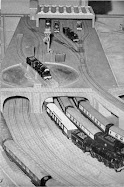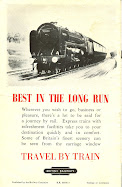 In 1948 British Railways' specialist staff of The Railway Executive Publicity department assembled a Gauge 'O' model railway, with many other departments of British Railways helping to make the model as authentic as possible. The following information and pictures are taken from publicity booklets that were published in the 1950s. The layout and its rolling stock were, it is assumed sold off or disposed of many years ago.
In 1948 British Railways' specialist staff of The Railway Executive Publicity department assembled a Gauge 'O' model railway, with many other departments of British Railways helping to make the model as authentic as possible. The following information and pictures are taken from publicity booklets that were published in the 1950s. The layout and its rolling stock were, it is assumed sold off or disposed of many years ago.Following its first appearance in 1948 the model was a feature of many exhibitions throughout the country, including the Daily Mail Ideal Home Exhibition and in Department Stores.
The text in the following paragraphs is copied straight from the leaflet
It is assumed that most of the locomotives and rolling stock were from Bassett Lowke. If anyone has any knowledge of where these models eventually found a home please comment.
LAYOUT
Normally measuring 30 ft. by 15 ft. (40 ft. by 21 ft., with the surrounding stand), the model railway is portable. Each table section, which measures 6 ft. by 3 ft., is mounted on independently adjustable legs to give a normal height of 2 ft. 9 in.
measures 6 ft. by 3 ft., is mounted on independently adjustable legs to give a normal height of 2 ft. 9 in.
It is assumed that most of the locomotives and rolling stock were from Bassett Lowke. If anyone has any knowledge of where these models eventually found a home please comment.
LAYOUT
Normally measuring 30 ft. by 15 ft. (40 ft. by 21 ft., with the surrounding stand), the model railway is portable. Each table section, which
 measures 6 ft. by 3 ft., is mounted on independently adjustable legs to give a normal height of 2 ft. 9 in.
measures 6 ft. by 3 ft., is mounted on independently adjustable legs to give a normal height of 2 ft. 9 in. The model was so designed and constructed that it could be assembled and dismantled in the shortest possible time, and this has imposed certain limitations on its scenic background. Thus the scenery is made of flexible material and the joints in the embankment are masked by small strips fashioned to resemble stone drainage.
TRACK
On a railway of this kind the track must be very strong and, at the same time, built to scale. The" Three Rail" system was adopted to allow metal sleepers to be used. These have embossed rail plates and carry the latest type of flat bottom rail to a scale length of 60 feet. They are fastened to a ballasted strip which, in turn, is fixed to the baseboards, giving the best possible appearance of a correctly ballasted track. The embankments are constructed with timber foundation and gradients are approximately 1 in 50. The bridges are replicas of types now in use.
SIGNALS
The layout is accurately signalled, in accordance with full size practice, both colourlight and semaphore signals being used. The railway is on view for weeks at a time and it has, for this reason, been found impracticable to keep signal lights burning as the life of electric bulbs is too short and replacements difficult. The semaphore signals are operated individually from the control panel.
ELECTRIC WIRING
TRACK
On a railway of this kind the track must be very strong and, at the same time, built to scale. The" Three Rail" system was adopted to allow metal sleepers to be used. These have embossed rail plates and carry the latest type of flat bottom rail to a scale length of 60 feet. They are fastened to a ballasted strip which, in turn, is fixed to the baseboards, giving the best possible appearance of a correctly ballasted track. The embankments are constructed with timber foundation and gradients are approximately 1 in 50. The bridges are replicas of types now in use.
SIGNALS
The layout is accurately signalled, in accordance with full size practice, both colourlight and semaphore signals being used. The railway is on view for weeks at a time and it has, for this reason, been found impracticable to keep signal lights burning as the life of electric bulbs is too short and replacements difficult. The semaphore signals are operated individually from the control panel.
ELECTRIC WIRING
Coloured and numbered plug and socket joints assist in the rapid assembly of the electric wiring installation which is carried on the underside of the tables. A flexible insulated wire is used to prevent breakages which are liable to occur through vibration in transit. A common return circuit is provided under each· table by a copper bar with a flexible connection to its neighbour, and this is tapped along its length to allow connections to be made thereto.
The locomotives work on 20 volt D.C., the current being supplied from A.C. mains through rectifiers. The D.e. current is fed to the control panel through two 12-volt 36-watt bulbs which act as fuses.
CONTROL
CONTROL
The control box has six separate panels, each equipped with stud type resistance, 12 sections and eight point levers. The number of panels in use depends upon the design of the layout to be worked.
Five panels are used to operate the layout shown on centre pages, divided as follows :-
Five panels are used to operate the layout shown on centre pages, divided as follows :-
(1) Up Main Line and Sidings.
(2) Down Main Line and Sidings.
(3) Goods Line.
(4) Locomotive Shed Roads.
(5) Goods Sidings.
Each line is split up into sections, the division being made in the most convenient place for operating purposes.
(2) Down Main Line and Sidings.
(3) Goods Line.
(4) Locomotive Shed Roads.
(5) Goods Sidings.
Each line is split up into sections, the division being made in the most convenient place for operating purposes.
All points are operated by double solenoid point motors working on 20 volt A.C. Points are normally set for the main line and an automatic lock holds the point in position after the blades have been moved.
The locomotives are operated through a stud-type resistance.
When the handle is at 90° on the quadrant no current is passing to the locomotive which is stationary. To start the train moving, the handle is brought slowly round in a clockwise direction from one stud to the next. The first stud allows only a small amount of current to flow and the locomotive starts moving forward. The next stud increases the current and thus the speed. The movement from one stud to another continues until the locomotive has attained a full scale speed.
The action is reversed back to 90° to stop the locomotive. As the current supply is reduced so the speed decreases until the locomotive is stationary.
Movement of the locomotive in the reverse direction is obtained by reversing the current to the locomotive which is automatically brought about by moving the handle from the 90° position in an anticlockwise direction-the opposite way to that which produced the forward movement.
POINTS (OR SWITCHES)
Movement of the locomotive in the reverse direction is obtained by reversing the current to the locomotive which is automatically brought about by moving the handle from the 90° position in an anticlockwise direction-the opposite way to that which produced the forward movement.
POINTS (OR SWITCHES)
Points are operated by drawing the appropriate lever forward when a passing electrical contact is made which energises one of the solenoids and the point blade is moved over. When the lever is moved back a similar contact is made which energises the other solenoid and the point blade moves in the reverse direction.
OPERATION
OPERATION
It is possible to have 2 passenger trains running, each on its own circuit, also a freight train on the goods line. An automatic coupling and uncoupling device enables a freight train to be made up or put away in the goods sidings or a passenger train to be drawn from or stabled in 2 passenger sidings.
LOCOMOTIV ES
ES
LOCOMOTIV
 ES
ES The types now in use on this model are as under :
BR. Standard Class 7 Loco. 70000.
B.R. Standard Class 5 Loco. 73001.
L.M.Region
Pacific," Sir William Stanier."
10,000 Class Diesel.
6P Class.
2-6-2 Tank.
Western Region
King Class.
1,000 Class.
Pannier Tank.
Eastern Region
Pacific, " A. H. Peppercorn."
B1. Class.
L.I. Class Tank.
Southern Region
Pacific, Merchant Navy Class.
Schools Class.
Diesel Shunting Locomotive.
(These are being added to as required.)
ROLLING STOCK
The rolling stock at present in use consists of the following vehicles :-
BR. Standard Class 7 Loco. 70000.
B.R. Standard Class 5 Loco. 73001.
L.M.Region
Pacific," Sir William Stanier."
10,000 Class Diesel.
6P Class.
2-6-2 Tank.
Western Region
King Class.
1,000 Class.
Pannier Tank.
Eastern Region
Pacific, " A. H. Peppercorn."
B1. Class.
L.I. Class Tank.
Southern Region
Pacific, Merchant Navy Class.
Schools Class.
Diesel Shunting Locomotive.
(These are being added to as required.)
ROLLING STOCK
The rolling stock at present in use consists of the following vehicles :-
Passenger.
Train of six Main Line Express passenger coaches representing " The Royal Scot " (L.M.R.).
Train of six Main Line Express passenger coaches representing the" Cornish Riviera Express" (W.R.).
Train of six Main Line Express passenger coaches representing " The Flying Scotsman" (E.R.).
Train of six Main Line Express passenger coaches representing " The Atlantic Coast Express" (S.R.).
Pullman Train, including observation car. Train of five Suburban steam train coaches.
Four-coach set of Main Line electric stock (S.R.). Two-coach set of Suburban electric stock (S.R.).
Horse Box.
Freight.
Ten 10-ton open wagons.
Ten 12-ton open wagons.
Three flat wagons with containers.
Eight covered vans (various types).
One six-wheeled milk churn van.
Three 8-wheeled flat wagons. One brick wagon.
One tar wagon.
One cattle truck.
Three brake vans.
Train of six Main Line Express passenger coaches representing " The Royal Scot " (L.M.R.).
Train of six Main Line Express passenger coaches representing the" Cornish Riviera Express" (W.R.).
Train of six Main Line Express passenger coaches representing " The Flying Scotsman" (E.R.).
Train of six Main Line Express passenger coaches representing " The Atlantic Coast Express" (S.R.).
Pullman Train, including observation car. Train of five Suburban steam train coaches.
Four-coach set of Main Line electric stock (S.R.). Two-coach set of Suburban electric stock (S.R.).
Horse Box.
Freight.
Ten 10-ton open wagons.
Ten 12-ton open wagons.
Three flat wagons with containers.
Eight covered vans (various types).
One six-wheeled milk churn van.
Three 8-wheeled flat wagons. One brick wagon.
One tar wagon.
One cattle truck.
Three brake vans.







